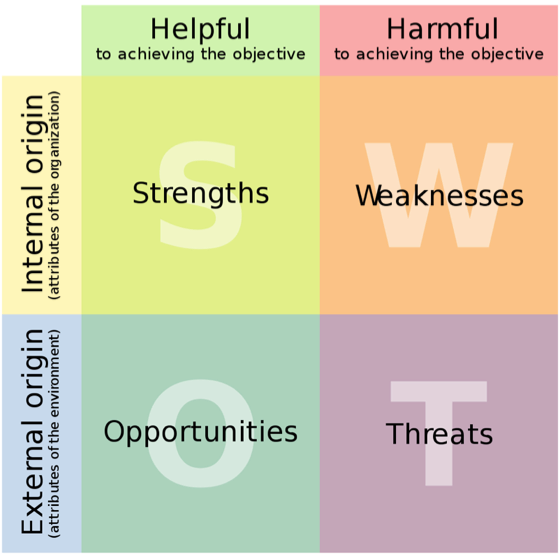Why you always have competitors, and how to assess them effectively
Paul Nebel
TL,DR;
Don’t fall into the trap of thinking you have no competition simply because there’s no-one out there who’s doing exactly the same thing as you. That cute cat video you just watched on YouTube? Even that is your competition in a world of short attention spans! The following simple steps can be used to give you a competitive edge:
- Use SEO keyword tools to find the most common search queries related to your product or service.
- Use a search engine with these terms to see who might be your competition.
- Look at their websites and examine their brand, messaging and product/service.
- Examine what their offering is, who it is aimed at, how they market themselves, what offers they are making.
- Learn where they are strong and where they are weak, and where you can fill a gap.
- Use this knowledge to help build a brand customers will recognise and trust.
You ain’t seen nothin’ like this before…
DAVID: So we became The Originals.
NIGEL: Right.
DAVID: And we had to change our name actually….
NIGEL: Well there was, there was another group in the East End called The Originals and we had to rename ourselves.
DAVID: The New Originals.
– This is Spinal Tap, A Rockumentary by Martin DiBergi
Anyone who thinks their start-up idea has no competition is a fool. There, I’ve said it. If you’re reading that statement and thinking to yourself ‘how dare you, no-one is producing an asynchronous audio/video story-sharing app like mine’ my answer is threefold:
- I’d be prepared to bet a great deal of money that you haven’t actually looked to see if you have any competition (and I mean really, properly, looked in a methodical and organised manner).
- Something doesn’t have to do exactly what you do to be the competition. I’ve described in previous posts how to find early adopters and one of their characteristics is that they are already paying to remove the pain they feel from their problem. Whatever they’re paying for is your competition, whether it actually solves the problem or not.
- Since the invention of kitten videos, every start-up (and I mean every… single… one…) is competing for their customers’ time and attention: YouTube, TikTok, Instagram, Twitter, Facebook, Clubhouse, Slack, Candy Crush, etc., etc., are all your competition.
The hardest competitor to beat will be the one your customers are using right now. In order to beat that competitor you will have to persuade existing customers to switch to your product or service, and people hate change. The rule of thumb is that your product/service will have to be at least 10x better than the incumbent for you to entice them away (admittedly, ‘10x’ better is very hard to quantify but suffice it to say that you will have to be much better!).
Your task is to understand not only who your competitors are in your business area of interest but also what else makes demands on the attention of you customer niche. Grabbing people’s attention is easy (just paint yourself purple and run down the street shouting “I’m a blueberry!” - that should do it), retaining people’s attention is really, really hard. Your aim is to turn attention into habit.
You need to decide what role you want to play in your target customer’s life, and the advantages and disadvantages that help you play that role.
Get into the habit of looking at competitors and asking yourself what you can take from their approach. Are they using a channel to access customers that gives them an advantage? Do they have special deals in place that you’re not offering? How are they going about solving the issues that you are trying to solve?
Ask not only ‘how does my customer benefit from this?’ - the user question - but also ‘how are we serving this need better than our competitors?’ - the product question - and ‘how can we show our customers that our product/service is the only logical choice for them?’ - the marketing question.
Take a long, hard look at yourself
Begin with a SWOT analysis. You’ve probably heard of this before. You’ve probably done this before. Just in case you haven’t, SWOT stands for Strengths, Weaknesses, Opportunities and Threats. This kind of analysis is typically done for the business as a whole, but in this context you should try to focus on competitive opportunities and threats.
SWOT analysis is attractive because of it’s simplicity, but it can lead to vague discussions. Its openness, which is its strength, can also become a weakness if the analysis is not directed which is why we concentrate on competition when completing the analysis.
SWOT asks four simple questions, two of which - what are your organisation’s strengths and weaknesses? - address internal issues. The remaining two - what opportunities does your organisation have and what threats does it face? - address your position within your environment. These last two are especially important when it comes to assessing competition. Two of these areas (strengths and opportunities) look at helpful areas whereas the remaining two (weaknesses and threats) look at harmful areas.
 |
|---|
| Figure 1: SWOT analysis table |
Conducting a SWOT analysis is straightforward: take a piece of paper or a whiteboard and divide it in two horizontally and vertically to create four quadrants. Label them as shown in Figure 1 above and take each section in turn, writing post-it notes and adding them to the relevant quadrant.
Don’t stop here. The beauty of this approach is that you can apply it to yourself and to your competition. In order to apply it to your competition you have to find out who they are.
Do your research
I’ve written in some detail in the past about how to use internet searches to analyse markets.
There are several tools that you can use to help you identify competitors. Start with Google Ads keyword planner tool as a means of identifying the search keywords most closely associated with your product/service. This is a free tool that, among other things, gives you an idea of the average number of monthly searches for any keyword combination. It also provides a range of cost-per-click bid prices that may help you get your site to the top of the first page of search results for specific keywords & keyword combinations (but beware, depending upon your industry the tool can grossly underestimate the actual cost of advertising).
Once you’ve found the keyword(s) you’re interested in, you can turn to sites like Moz.com to find out which businesses rank highly for those keywords - in other words, your competition. This is a paid-for service, but they have a number of SEO tools including their keyword explorer which you can use for free for up to 10 searches per month (you will have to create an account but you don’t have to commit to anything).
I recommend honing in on your keywords using Google, then going to Moz for extra information. For example, you can export a spreadsheet containing the URLs of the top 10 sites returned by Moz that are related to your keywords. Compare this with what is returned for a simple Google search using the same keywords. Note that Moz uses a variety of data sources and will not be able to return information about sites with low traffic, but then again you probably don’t need to worry about them anyway! You should now have a list of potential competitors to explore.
Don’t just copy, steal
Good Artists Copy; Great Artists Steal
The above aphorism has been attributed to Pablo Picasso and Igor Stravinsky (amongst others). It encapsulates the idea that artists may recontextualise, remix, substitute, or otherwise mashup existing work to create something new.
Now that you’ve identified your competition it’s time to learn from them. I encourage you to embrace your internal artist. Use the principles embedded in this aphorism to enhance your own business by asking the following questions of each potential competitor you have identified:
- How do they position themselves in the market? What is the essence of their offering?
- Who is their target audience? How much does this overlap with the niche you have identified for your own offering?
- What makes them different? What unique value are they offering to their audience?
- What are they doing well or badly? What do their audience like and dislike about them?
Companies fall over themselves to tell you what they are doing well, but understandably prefer to hide what is not going so well. To get a feel for what customers don’t like, try typing “company name bad review” into Google.
Once you’ve asked these questions of your competition, ask yourself if you see any patterns emerging in the way they do things. Are there any obvious opportunities for offering a superior product or service? Are there any best practices that you may need to adopt? Above all, what action(s) can you take from what you have learned?
Don’t just test your own product or service, take your competitor products and services for a spin to see what you can learn. This will give you the opportunity to see them from a user’s point of view. What are their strengths and weaknesses (which can feed into the SWOT analysis described above)? How do their target users experience the core tasks and features? What opportunities do you see for enhancing your own advantages? By the way, the best way to test your own product or service is to eat your own dogfood.
The medium is the message
The heading of this section is a phrase coined by the Canadian communication theorist Marshall McLuhan. The way he meant it is that the effect of something (e.g. technology) is more important than the thing itself. I’m using it here to refer to your brand. In this context, you can take his statement much more literally.
You’ve taken a detailed look at your competitors. It’s time to turn the spotlight on yourself. Your brand signifies all the good things that you can do for your customers, if only in their own minds. It is your identity and reputation. Is it doing the work you need to set the right expectations for your product or service. Does it help customers understand that you are better than the competition?
For many products or services the brand is the product/service itself. It is the experience the user has. The visual design is merely the brand identity, not the brand in and of itself. Here are some questions you need to ask of your brand:
- Attributes - What characteristics do you want people to associate with your product or service? Is your brand getting that message across successfully? What characteristics to you want to avoid?
- Value - What does your product or service do for customers that your competitors to not? Does your brand make this clear?
- Perspective - What associations do your customers have with your product or service? What associations do you want them to have?
The take-away
You don’t need to conduct an examination of the competitive landscape. Plenty of companies get by without doing one. Just be aware that knowledge is a competitive advantage. If you look at them in detail but they don’t look at you then you have that advantage.
Remember, though, that this landscape is changing all the time. New competitor products and services enter and leave the market all the time. The market itself is constantly changing, as are your customers. Any analysis of the competition will only be a snapshot, but it may be extremely useful as a means of assessing your own value, and of making that value clear to your customer niche.
What’s not to like about that?
A fond farewell
This may be my last blog post for Geovation. I’ve decided to move on and set up my own consultancy offering the same Virtual CTO and Business Advisor services I’ve provided for Geovation, but by myself.
I intend to apply exactly the same methods, techniques and processes I’ve been blogging about here and teaching to Hub members to myself and my own company. After all, they’re not specific to technology start-ups, and I’m going to be a start-up myself. If you’re interested in the journey you can read about it here.
I will be working on behalf of Geovation at least until July of 2021, offering free workshops to all hub members which you can book here. I’d be delighted if you connected with me on LinkedIn.
I wish my former Geovation colleagues all the best for the future, and hopefully I’ll see you in the Hub sometime soon.


Leave a Comment